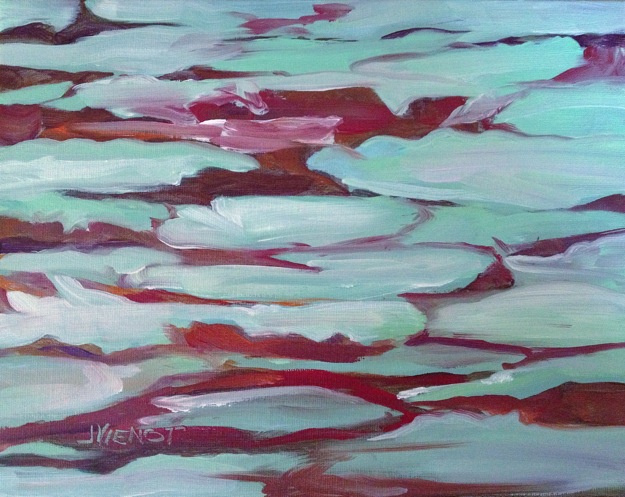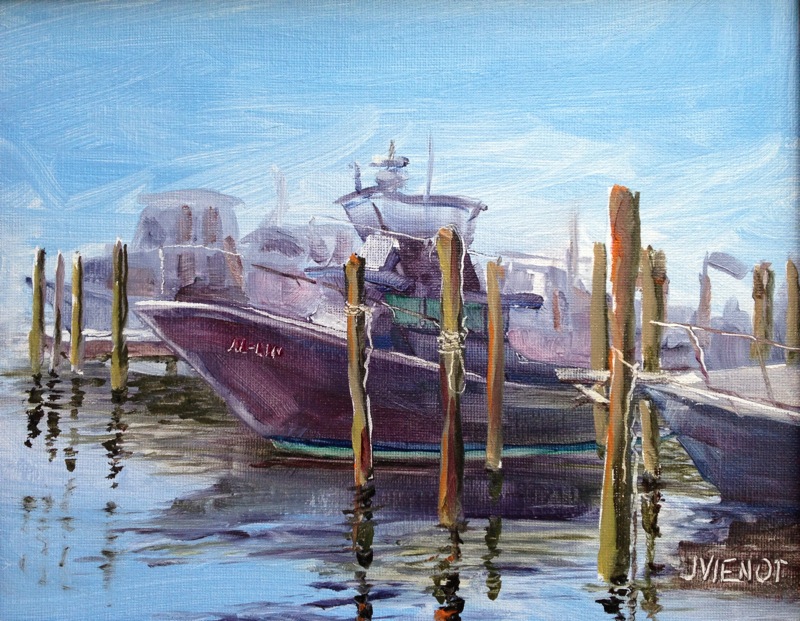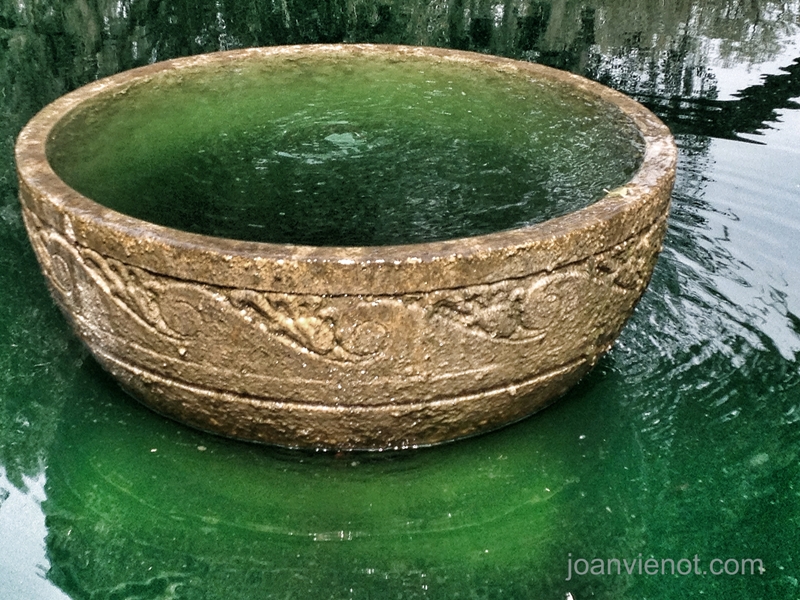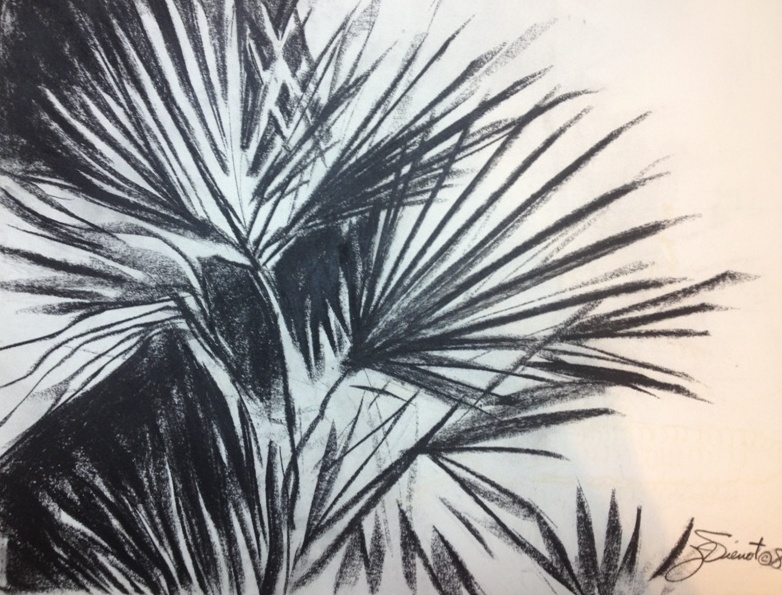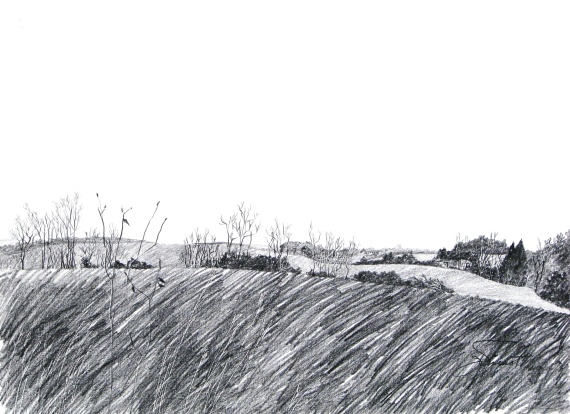
ArtsQuest Fine Art and Music Festival has come and gone, and in its wake, the familiar feeling of having passed through a wormhole in time and space, a sort of time warp, coming out on the other side with everything the same and yet very much changed.
Members of the sponsoring agency, the non-profit Cultural Arts Alliance of Walton County, are invited to exhibit 3 pieces of their artwork in the member tent, in exchange for 4 hours of volunteer work at the festival. For my volunteer work, I was asked to defend some No Parking cones and to move them out of the way when exhibiting artists needed to get through to set up their booths. It was the first time that I had seen booths being set up. My only exposure to setting up tents has been for overnight camping, and it is in light of that experience that I can pronounce tent-raising to be a close second to two-person canoeing for the fast track to divorce court, so I was fairly amazed at the calm and congeniality of the artists doing their nesting. The next day I helped set up the Emerald Coast Plein Air Painters tent and found it to be not at all unpleasant, so I think the key ingredient is having artists do the job.
The festival opened Friday afternoon. The experience was invaluable. With the tunes of Kelsey Anna and Matt miller and later Cody Copeland wafting over the grounds, I painted plein air near our booth the first afternoon, and again on the afternoon of the third day, the air filled by other musicians. The rest of the time I talked to the passers-by about the plein air art and artists and I explained what plein air painting is to everyone who would listen. Almost no one knew that plein air painting simply means painting in open air, on-site, looking at the scene you are painting.
We enjoyed great exposure at our booth, picking up some 30 email addresses to add to the 95 that already receive weekly notices of our next plein air painting location. One of the regular participants in our outings, Melody Bogle, had submitted her work and been juried into the festival, so she had her own booth. We all were overjoyed when the announcement came that she had won Best in Show for the 2013 Festival. With more than 100 artists juried into the festival, I felt like her win validated plein air painting to the show-goers.
I painted the painting at left on the first afternoon of the ArtsQuest Fine Art Festival. It shows the plein air tent and the row of tents that housed the CAA members’ exhibit in front of the concrete pond in Cerulean Park at Watercolor, Florida. I re-painted the lawn when I got back to my home studio, because the shadows made the pond look like it was higher than the tents. By removing the shadows and instead painting some downward-curving lawn contours, it was a quick fix to make the pond look lower than the tents. Perspective and postion are, after all, merely optical illusions. I compressed the scene to show only the tents, without any of the commercial buildings that were actually there fronting the streets of the beautiful village of Watercolor, Florida.
I own and manage a swimming pool service company as my “day-job”. One of my customers came by the plein air booth, and I enjoyed showing her my work. After the festival closed, she came to my home studio to see more of my work. As I develop my skills and learn the business of being an artist, I am recognizing that every experience is another notch in my belt, each in itself valuable for future actions and interactions. (Thank you for taking the time to visit with me, Becky Arnold. Did you realize you were contributing to my training?)
 At right is the completed version of the painting I posted last week, the brightly colored building in downtown Grayton Beach that houses Shorty’s Restaurant. After I got back to the studio, I realized that I had not painted the railings nearest me, or the flower pot that had attracted me to that point of view in the first place! To paint it plein air, I had positioned myself with my back to the sun with the unfortunate result that both my palette and my canvas were so brightly lit that I was “snow-blind” for most of the morning while I painted. It is truly a wonder that my colors turned out to be fairly close to correct! But that’s my excuse for not painting the railing and flowerpot until I got back to the studio.
At right is the completed version of the painting I posted last week, the brightly colored building in downtown Grayton Beach that houses Shorty’s Restaurant. After I got back to the studio, I realized that I had not painted the railings nearest me, or the flower pot that had attracted me to that point of view in the first place! To paint it plein air, I had positioned myself with my back to the sun with the unfortunate result that both my palette and my canvas were so brightly lit that I was “snow-blind” for most of the morning while I painted. It is truly a wonder that my colors turned out to be fairly close to correct! But that’s my excuse for not painting the railing and flowerpot until I got back to the studio.
Below left is the piece I painted this week at the regular weekly Emerald Coast Plein Air Painters outing, at Nick’s Rstaurant on the Bay, west of Freeport, FL. I worked very hard on figuring out how to make convincing pine trees, most particularly the brush strokes and stamps to use to show the so-very-important silhouette edge, and also the layering of values to show the masses of the needles. In this part of my process, that is one of my goals, to be able to learn to quickly portray recognizable forms just by using a few simple brushstrokes. I was not as comfortable with my efforts with the rippling reflections in the water below the trees. I reworked them in the studio, and came up with a fair representation of the lattice-like pattern. I was not at all successful with the muted land-mass on the horizon, across the Bay. I painted it and scrubbed it out 3 times plein air, never able to achieve a straight and level line that I was happy with. The horizon you see now was painted this morning in the studio.
And below right is the beginning of a painting that I started the last afternoon of ArtsQuest. The family in the picture was watching me paint, and asked if I might be able to put them in it, since they had been watching the watercolor workshop while I was painting. They want to see it when I finish it, so now the pressure is on!! I had fun with this painting at ArtsQuest, letting a few of the people in my audience paint a spot of color here or there. It was interesting how without fail, they would at first decline, but once the brush was in their hand, they would start smiling, daubing a little color or texture here or there! I think they all will be making a trip to pick up art supplies this week!
 |
 |
I was pleased that another one of my photographs was published this week, to illustrate a story by my friend Leslie Kolovich, host of The Stand Up Paddle Radio Show, for her column in The Paddler ezine, a United Kingdom publication. The article can be found at http://www.issuu.com/thepaddler/docs/thepaddler_8.

Most of my paintings and images are available for purchase. Contact me if you are interested. — Joan Vienot


 Considering all of the exposure opportunities today, no artist should be “unknown”. With a little footwork and by using my few computer skills, I have solidified my presence as an artist, both in my community and also elsewhere.
Considering all of the exposure opportunities today, no artist should be “unknown”. With a little footwork and by using my few computer skills, I have solidified my presence as an artist, both in my community and also elsewhere.


